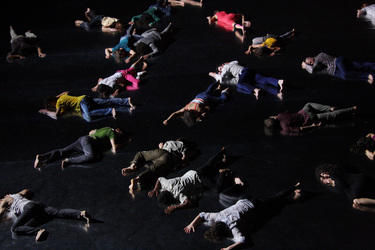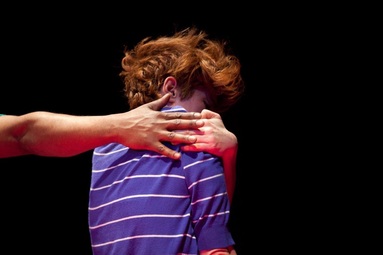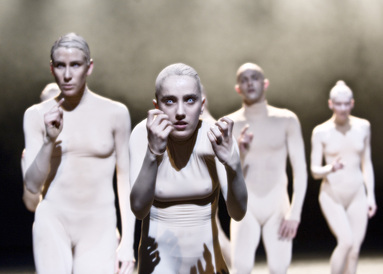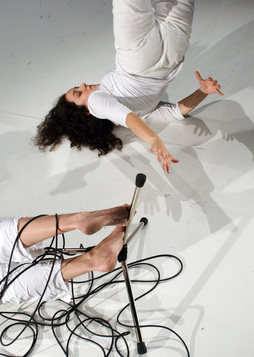 Levée des conflits, photo by Caroline Ablain Levée des conflits, photo by Caroline Ablain As my years as a dance critic pile on, it’s probably to be expected that I see more and more works I’ve already seen. This year, I can think of at least five off the top of my head. The one that most stood up to a repeat viewing was Matija Ferlin and Ame Henderson’s The Most Together We’ve Ever Been. I took the bus to Ottawa to see it just as a snowstorm was hitting the city. The ride ended up taking four hours. I barely had enough time to shove some of the worst food I’ve ever had in my mouth before running over to Arts Court, an old courthouse that has been turned into a beautiful art space. And, as soon as the show started, I knew it was all worth it. Back in Montreal, Israeli choreographer Sharon Eyal made a much-anticipated return after six years with Corps de Walk, a show she created with her partner Gai Behar. The uniformity she imposed on the twelve dancers of Norway’s Carte Blanche was oppressive and disturbing. It was its own indictment of homogeneity. At the Biennale de gigue contemporaine, the always reliable Nancy Gloutnez stood out yet again. With Les Mioles, she borrowed from classical music and became a conductor, turned her dancers’ feet into instruments, and composed a score reminiscent of Steve Reich in its obsessive build-up. After years of being one of the most rigorous emerging choreographers in Montreal, Sasha Kleinplatz has now fully emerged with Chorus II. The audience stood above six male dancers who swayed between demonstrations of physical strength and chill-inducing vulnerability. It is now up to venue artistic directors everywhere to shine on Kleinplatz the spotlight she so clearly deserves. Speaking of which, 2013 was the year of Agora de la danse. They probably had their best programming since I started following dance. It all began with Karine Denault’s Pleasure Dome, in which musicians and dancers explored pleasure without ever lazily resorting to shortcuts. Rather, she allowed the meaning of the work to emerge on its own and for Pleasure Dome to impose itself by the same token. It was followed by When We Were Old, a duo by Québec’s Emmanuel Jouthe and Italy’s Chiara Frigo (presented in collaboration with Tangente). The choreographer-dancers managed to bypass every single contemporary dance cliché that usually occurs as soon as a man and woman are onstage. In each and every moment, their encounter felt fresh and sincere. Agora ended the year with Prismes by Benoît Lachambre, who a month later would win the Montreal Dance Prize. Created for Montréal Danse, Prismes explored the effect of light on perception in a chromatic environment, as well as the fluidity of gender. Lighting designer Lucie Bazzo outdid herself for this highly experiential work. At the Festival TransAmériques, it was French choreographer Boris Charmatz who stood out with Levée des conflits, an opus of twenty-five movements repeated as a canon by twenty-four dancers. From the simplicity of the choreography to the high number of performers, Levée des conflits impressively hovered between minimalism and excess. I spent the summer in Iceland, where my trip ended with the Reykjavík Dance Festival. There, Norway’s Sissel M Bjørkli presented one of the most singular shows I’ve ever seen with Codename: Sailor V. It took place in a tiny space, barely big enough to seat fifteen. The smoke that filled the room along with Elisabeth Kjeldahl Nilsson and Evelina Dembacke’s intensely saturated coloured lighting blurred the edges of everything. Inspired by anime, Bjørkli created an alter ego for herself and through imaginative play managed to turn an office chair into a spaceship. That shit was magical. So was Nothing’s for Something by Belgium’s Heine Avdal and Yukiko Shinozaki, which opened with a ballet for six curtains, each suspended by six huge helium-filled balloons. Set to classical music, it was reminiscent of Disney’s Fantasia. For its finale, eight such balloons were left to float around the room while emitting breathing sounds, appearing like disembodied alien visitors. Soon after my return to Montreal, Marie Chouinard presented Henri Michaux : Mouvements. The genesis of this work, when Carol Prieur first incarnated the drawings of Henri Michaux back in 2005, is the reason why I’m a dance critic today. Seeing the twelve dancers of Chouinard’s company lend themselves to the exercise was just as riveting eight years later. By translating drawings into movement, Chouinard demonstrated the power of dance to think the body creatively. Usine C ended the year on a high note with their program from the Netherlands, most especially Ann Van den Broek’s feminist work for three female dancers, Co(te)lette. The show was powerful in its exposition of women’s bodies as a site of tension, torn between being objects of desire and embodied subjects. We can only hope that there will be more works like it in 2014.
0 Comments
 When We Were Old, photo by Adrienne Surprenant When We Were Old, photo by Adrienne Surprenant “I bring you somewhere.” If you’re going to follow her, truly follow her, you need to trust her. Choreographers Chiara Frigo (Italy) and Emmanuel Jouthe (Québec) might hold hands with fingers interlaced, but it’s the only codified gesture you will find in When We Were Old. It is their starting point, a sign of trust and desire for true connection, from which anything can happen. Their relationship and the movements that stem from it are not predetermined. They are not playing roles. Their meeting is perpetual, occurs in each moment, like when they let go of each other, evolve independently, find each other again, and everything is to be done again. As a result, their meeting feels sincere. It also allows the performers to bypass all kinds of contemporary dance clichés that often emerge as soon as a woman and a man are onstage. Their duet is neither coupley, nor antagonistic. It just feels honest. It is no coincidence that, after the show, my date told me, “I liked that she was never weak.” Jouthe and Frigo are trying to build something together and, like the tree trunks they use as building blocks for her to stand on, the structure might end up making things shakier than no structure at all. And that’s okay. That’s the risk one takes in building a relationship or a dance. Even the Marley that covers the floor is loose, not taped down, and can be unrolled or rolled up, allowing change and surprise. Beneath, a new floor might be revealed, or even a new costume. It is as malleable as their relationship. Her movement is more spastic; his, more fluid and smooth. As they hover from side to side in opposite directions, they only ever meet for a brief moment in the middle. And that’s enough. By the end, it might even allow them to transform into dinosaurs among mountains made of chairs. It all depends on whether you trust them enough to bring you there. April 24-26 at 8pm Agora de la danse www.agoradanse.com / www.tangente.qc.ca 514.525.1500 Tickets: 28$ / Students or under 30: 20$  Sharon Eyal & Gai Bachar’s Corps de Walk, photo by Erik Berg Sharon Eyal & Gai Bachar’s Corps de Walk, photo by Erik Berg Benoît Lachambre’s Snakeskins: because you can only accuse Lachambre of being so hit-or-miss due to his uncompromising commitment to his artistic pursuits… and he’s due for a hit. (October 10-12, Usine C) Nicolas Cantin’s Grand singe: because nobody else manages to pack as much punch by doing so little. (October 30-November 1, Usine C) Brian Brooks’s Big City & Motor: because Brooks explores concepts that only push his choreography further into the physical world, turning the human body into little more than a machine. (November 22-25, Tangente) Karine Denault’s PLEASURE DOME: because we haven’t seen her work since 2007, when she presented the intimate Not I & Others using only half of the small Tangente space, dancing with humility, as though the line between performer and spectator simply hinged on a matter of perspective. (February 6-9, Agora de la danse) Pieter Ampe & Guilherme Garrido’s Still Standing You: because Ampe & Garrido have created one of the most compelling shows of the past few years, a dense study of masculinity and friendship covered with a thick layer of Jackass trash. (February 12-16, La Chapelle) Sharon Eyal & Gai Bachar’s Corps de Walk: because it’s the first time we get to see a work by Eyal in six years, when she blew us away with a non-stop human parade that was decidedly contemporary in its transnationalism and use of everyday movements like talking on cell phones. (February 28-March 2, Danse Danse) Mélanie Demers’s Goodbye: because, much like David Lynch did with Inland Empire, Demers demonstrated that an artist doesn’t need to instill suspension of disbelief in its audience to work, that dance can be powerful as dance just as film can be powerful as film. (March 20-22, Usine C) Maïgwenn Desbois’s Six pieds sur terre: because Desbois demonstrated that one doesn’t need to sacrifice art in order to make integrated dance. (March 21-24, Tangente) Yaëlle & Noémie Azoulay’s Haute Tension: because Yaëlle Azoulay came up with the most exclamative piece ever presented at the Biennales de Gigue Contemporaine. (March 28-30, Tangente) Dorian Nuskind-Oder’s Pale Water: because with simple means Nuskind-Oder manages to create everyday magic. (May 10-12, Tangente)  CINQ HUMEURS, photo de Charles Darbonne CINQ HUMEURS, photo de Charles Darbonne Je viens du Musée d’Art Contemporain où j’ai visionné une vidéo d’un escargot se déplaçant d’un côté du cadre à l’autre, un processus qui lui prend plus de six minutes. Il s’agit de Scenes from Ordinary Life de l’artiste torontois Euan Macdonald. Il est possible que ce visionnement ait coloré mon expérience subséquente de CINQ HUMEURS, la nouvelle pièce de groupe d’Emmanuel Jouthe présentée cette semaine à l’Agora de la danse. Il demeure que des liens entre les deux œuvres se sont dessinés sous mes yeux au courant de la soirée. Ce que je remarque en premier dans CINQ HUMEURS est la juxtaposition des vitesses, dans le même corps et à travers les corps. Comme si le chorégraphe détenait une télécommande : slow motion, fast forward. Souvent, les mouvements les plus originaux apparaissent lorsque les contraintes sont les plus claires. Dans CINQ HUMEURS, par contre, il est plus approprié de parler de complications que de contraintes. Deux femmes courent à toute vitesse, mais elles sont couchées sur le sol, de sorte que leur déplacement est quasi inexistant. Une autre femme marche d’un côté à l’autre de la scène, les yeux fermés. D’autres se déplacent à haute vitesse, mais leur tête descend de plus en plus bas, jusqu’à ce que leurs bras rejoignent le sol. Ces complications éliminent la distance entre l’humain et l’animal, et révèle la futilité du mouvement de ces créatures qui se démènent. Alors pourquoi se démener? Un homme se laisse tomber, droit comme une planche. À la dernière seconde, un autre l’attrape par le cou. Pour un instant, on se retrouve dans l’univers de Staccato Rivière, une pièce de Jouthe datant de 2007. Une vision de l’humain comme statue, soumis comme tout autre objet à la gravité, plongeant inévitablement vers sa propre fragilité. Tout n’est pas si fataliste, par contre. Dans les sections les plus vigoureuses, brèves, les bras deviennent des catapultes qui font pivoter le corps et les jambes sont propulsées hors du tronc telles des armes. Jouthe réussit malgré tout à résister une structure dramatique. La chorégraphie qui accompagne la section la plus intense des Quatre Saisons de Vivaldi, la musique qui inspire le spectacle, consiste en deux ou trois femmes qui marchent en cercle, à reculons. Je prends par cette occasion l’opportunité de souligner la performance de Marilyne St-Sauveur, dont le talent n’est pas limité à sa performance comique. Elle possède une aura de mystique qui attire le regard, et ce même lorsqu’elle partage la scène avec neuf autres interprètes. La section finale menace de défaire cette anti-pièce lorsque les dix danseurs se pointent sur scène et attaquent le mouvement, mais le tout est coupé court. Éjaculation prématurée. Ne reste qu’une seule danseuse qui se tient immobile, à cheval entre scène et coulisses, avant de disparaître à son tour. Une fin qui a du culot. Et je repense à cet escargot qui avance lentement. Son mouvement n’est pas moins signifiant que ces humains qui se démènent. Tous deux se réalisent de par leur mouvement, de par leur vie. Alors pourquoi se démener? CINQ HUMEURS 16-18 mars à 20H, 19 mars à 16H Agora de la danse www.agoradanse.com 514.525.1500 Billets : 20$ / Étudiants et moins de 30 ans : 14$ |
Sylvain Verstricht
has an MA in Film Studies and works in contemporary dance. His fiction has appeared in Headlight Anthology, Cactus Heart, and Birkensnake. s.verstricht [at] gmail [dot] com Categories
All
|
 RSS Feed
RSS Feed